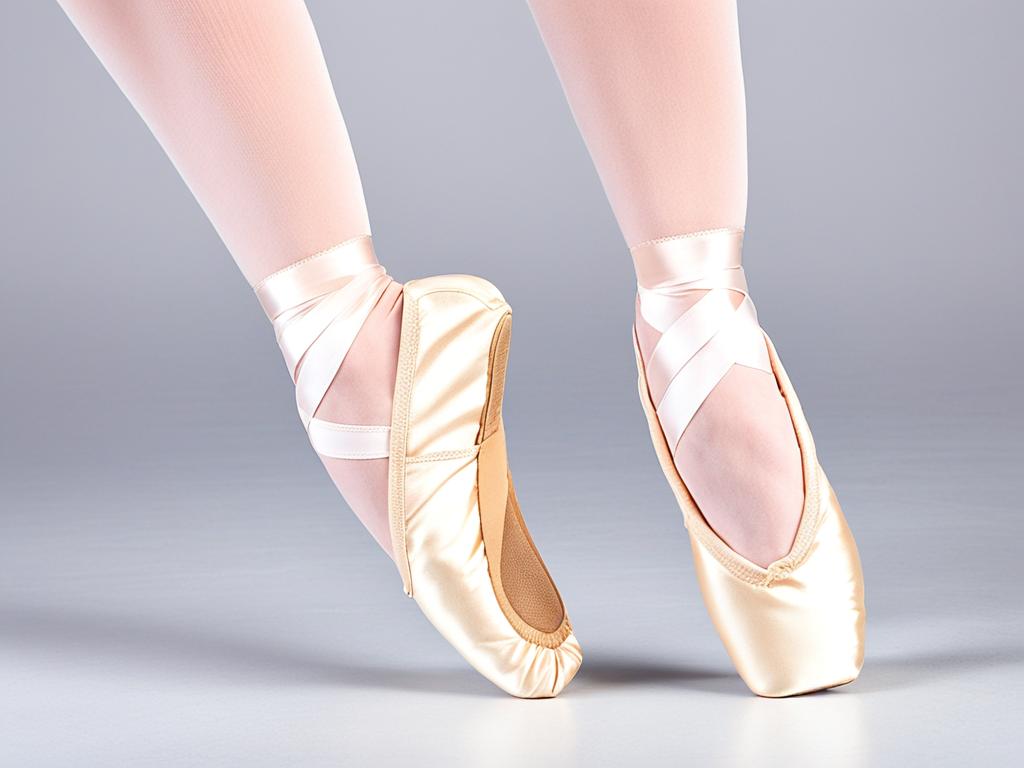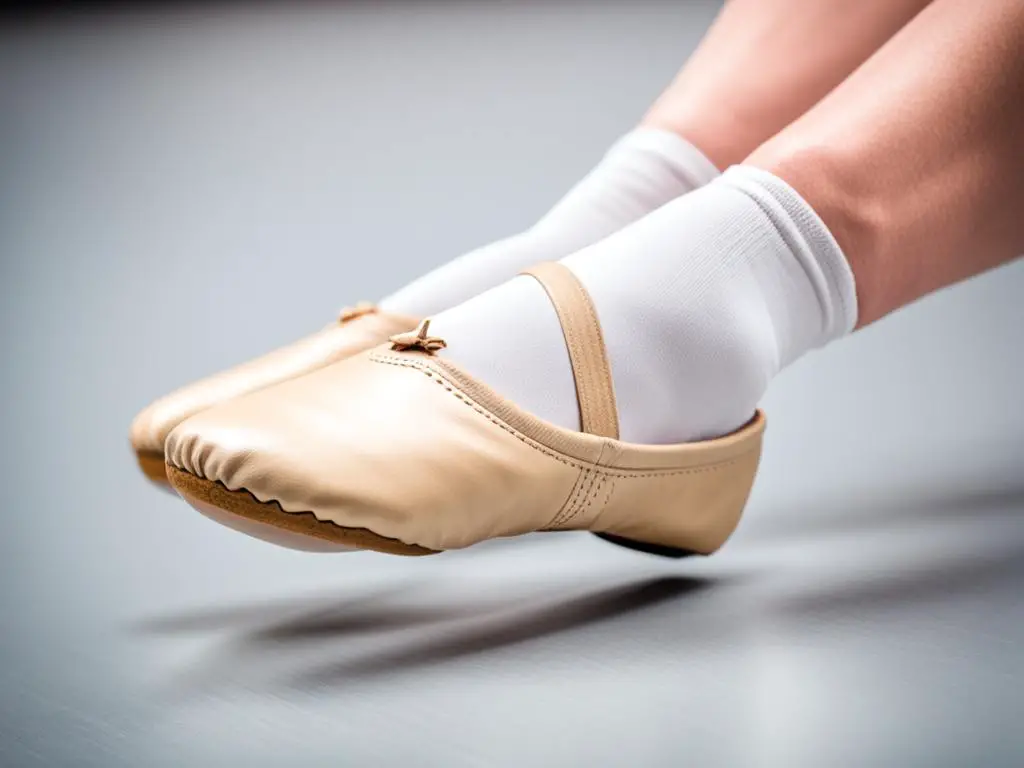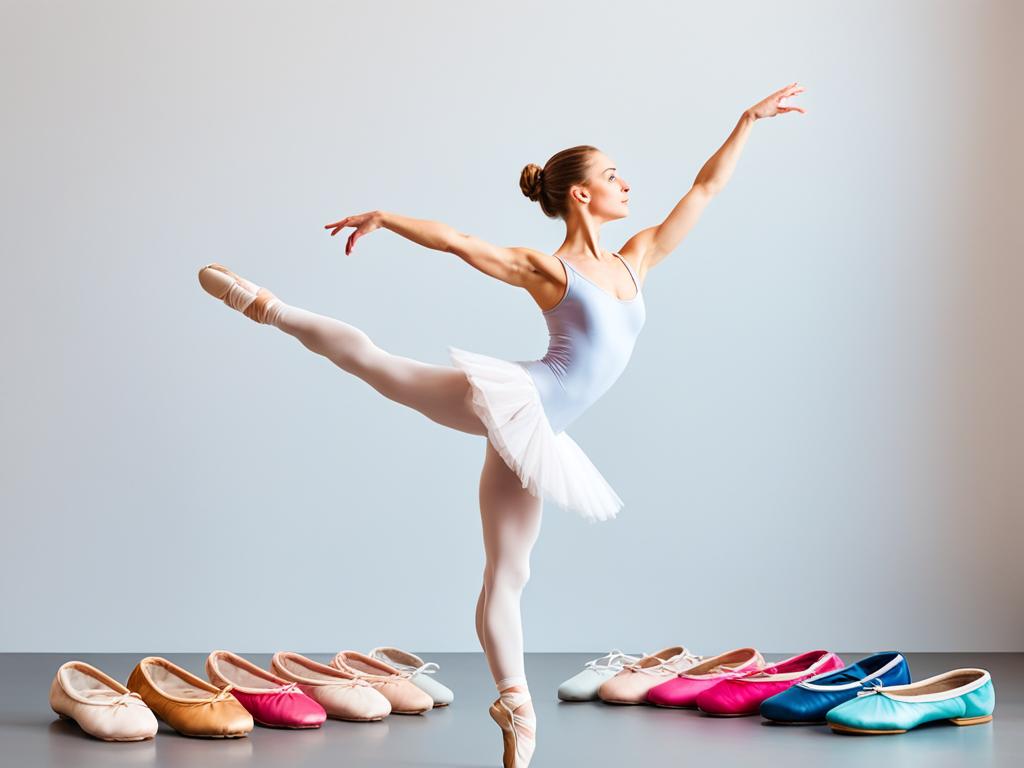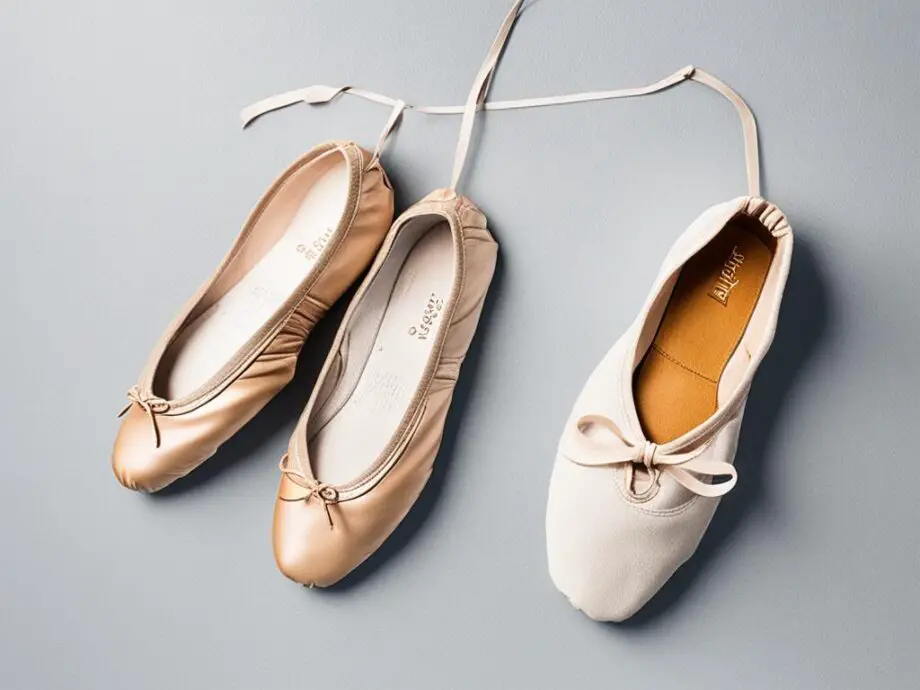When it comes to choosing the perfect ballet shoes, dancers are often faced with the decision between canvas and leather. Both materials have their own unique advantages and characteristics, making the choice a matter of personal preference and individual needs. In this article, we will delve into the differences between canvas and leather ballet shoes, comparing their comfort, durability, and performance. Whether you’re a beginner or a seasoned dancer, this comprehensive buying guide will help you make an informed decision.
Key Takeaways:
- Canvas and leather are two common materials used in ballet shoes.
- Canvas ballet shoes offer flexibility and breathability, making them comfortable for dancers.
- Leather ballet shoes are known for their durability and longevity.
- Comfort and fit play a crucial role in choosing the right ballet shoes.
- Durability and longevity are important considerations for dancers looking for a long-lasting investment.
Canvas Ballet Shoes: Benefits and Features
When it comes to ballet shoes, canvas is a popular choice among dancers for its numerous benefits and exceptional comfort. Let’s delve into the advantages and features that make canvas ballet shoes a top pick for performers.
Comfort and Flexibility
One of the key benefits of canvas ballet shoes is their exceptional comfort. The soft and lightweight material molds effortlessly to the foot, providing a snug yet flexible fit. Dancers can move with ease, experiencing minimal restrictions, allowing for fluid movements and beautiful lines.
Breathability
As dancers put in hours of practice and performances, foot health and comfort become paramount. Canvas ballet shoes offer superior breathability, allowing air to circulate and prevent excessive sweating. This ventilation helps to keep feet dry, reducing the risk of discomfort and blisters.
Durability
While leather ballet shoes are often praised for their durability, canvas ballet shoes have come a long way in terms of longevity. With advancements in technology and construction, canvas shoes now offer enhanced durability, making them suitable for both professional dancers and those starting out.
Additional Advantages
“Canvas ballet shoes also offer several additional advantages over leather. The material is known for its ability to stretch and conform to the shape of the foot over time, providing a customized fit. This allows dancers to achieve optimal comfort and control during their performances.”
Canvas Ballet Shoes vs. Leather Ballet Shoes
| Canvas Ballet Shoes | Leather Ballet Shoes |
|---|---|
| Exceptional comfort and flexibility | Traditional durability and strength |
| High breathability | Long-lasting durability |
| Customizable fit over time | Naturally molds to the foot |
| Lightweight and soft | Luxurious and elegant |
As you can see, canvas ballet shoes offer a range of benefits and features that make them an excellent choice for dancers seeking comfort and flexibility. Whether you’re a beginner or an experienced performer, canvas ballet shoes will support you every step of the way, allowing you to express your artistry with grace and precision.

Leather Ballet Shoes: Advantages and Characteristics
When it comes to ballet shoes, leather offers a range of advantages that make it a popular choice among dancers. Not only does it provide exceptional durability and longevity, but it also offers unique benefits that enhance the dancer’s overall experience.
Let’s start with the durability aspect. Leather ballet shoes are known for their ability to withstand rigorous dance routines and regular use. The high-quality leather material is resistant to wear and tear, ensuring that the shoes can withstand the demands of frequent rehearsals and performances. This durability factor makes leather ballet shoes a reliable and long-lasting investment for dancers.
Furthermore, leather ballet shoes offer exceptional longevity compared to other materials. With proper care and maintenance, these shoes can continue to provide support and comfort for an extended period. Whether you’re a professional dancer or a ballet enthusiast, choosing leather ballet shoes guarantees that you’ll have a reliable pair that will accompany you through countless performances.
In addition to durability and longevity, leather ballet shoes also provide unique benefits that contribute to the dancer’s overall experience. The natural material molds to the dancer’s foot, providing a customized fit that enhances comfort and support. This allows dancers to move with grace and confidence, knowing that their shoes are perfectly tailored to their feet.
Leather ballet shoes also offer excellent breathability, ensuring that the dancer’s feet remain cool and dry throughout rehearsals and performances. The breathable nature of leather prevents excessive perspiration, keeping unpleasant odors at bay and reducing the risk of bacterial growth. This feature not only enhances comfort but also contributes to the overall hygiene of the shoes.
When it comes to comfort and performance, leather ballet shoes have proven to be a reliable choice. The material provides sufficient support and flexibility, allowing dancers to execute precise movements with ease. Additionally, leather offers excellent traction, ensuring stability and preventing slips or falls during intricate dance routines.
“Leather ballet shoes provide exceptional durability and longevity, ensuring reliable support for dancers. The natural material molds to the foot, offering personalized comfort and enhancing performance. With their breathability and reliable traction, leather shoes are a favored choice among dancers.”

Advantages of Leather Ballet Shoes:
| Advantages | Characteristics |
|---|---|
| Exceptional Durability | Resistant to wear and tear, withstands rigorous dance routines |
| Longevity | With proper care, provides support for an extended period |
| Customized Fit | Molds to the dancer’s foot for enhanced comfort and support |
| Breathable | Prevents excessive perspiration and odors, maintains foot hygiene |
| Excellent Traction | Ensures stability and prevents slips during performances |
Comfort and Fit: Canvas vs Leather Ballet Shoes
When it comes to ballet shoes, comfort and fit are of utmost importance for dancers. In this section, we will compare the comfort levels and fit of canvas and leather ballet shoes. Understanding how these materials mold to the dancer’s foot and provide the necessary support can help dancers make an informed choice based on their individual preferences and dancing styles.
Flexibility
One key factor that contributes to the comfort of ballet shoes is their flexibility. Both canvas and leather ballet shoes offer different levels of flexibility, which can significantly impact the dancer’s comfort and movement.
“Canvas ballet shoes are known for their exceptional flexibility, allowing dancers to achieve a wide range of movement effortlessly. The fabric conforms to the foot and enhances the dancer’s ability to point and flex. On the other hand, leather ballet shoes may require some break-in time for optimal flexibility, but they do provide excellent support and shape retention.”
Support
The level of support provided by ballet shoes is another crucial aspect to consider for comfort and fit. Proper support helps prevent injuries and ensures that the dancer feels secure during their movements.
“Canvas ballet shoes offer a snug, glove-like fit that contours to the foot’s shape while providing ample support. The more a dancer wears canvas ballet shoes, the better they conform to their feet, resulting in enhanced support. Leather ballet shoes, although initially stiffer, offer robust support and are highly recommended for dancers who require additional stability and structure.”
Molding to the Foot
The ability of ballet shoes to mold to the dancer’s foot is essential for optimal comfort and fit. This factor ensures that the shoes adapt to the unique shape of the dancer’s foot, providing a personalized fit.
“Canvas ballet shoes excel in molding to the dancer’s foot due to the soft and flexible material. With each wear, they conform to the foot, creating a customized fit that enhances comfort. Leather ballet shoes also mold to the foot over time, offering a snug and supportive fit as they break in.”
In summary, both canvas and leather ballet shoes have their advantages when it comes to comfort and fit. Canvas shoes provide exceptional flexibility and natural molding to the foot, while leather shoes offer robust support and shape retention. It ultimately boils down to personal preference and the specific needs of the dancer. Experimenting with both materials can help dancers determine which offers the perfect balance of comfort and fit for their unique style and requirements.

| Comfort and Fit Comparison | Canvas Ballet Shoes | Leather Ballet Shoes |
|---|---|---|
| Flexibility | Exceptional flexibility, allowing for a wide range of movement | Requires break-in time for optimal flexibility |
| Support | Snug fit with ample support | Initial stiffness with excellent support and structure |
| Molding to the Foot | Soft and flexible material molds to the foot for a customized fit | Molds to the foot over time for a snug fit |
Durability and Longevity: Canvas vs Leather Ballet Shoes
In the world of ballet, durability and longevity are key factors to consider when choosing the right pair of shoes. In this section, we will explore how canvas and leather ballet shoes stack up in terms of their ability to withstand the demands of rigorous training and performances.
Canvas ballet shoes are renowned for their lightweight and flexible nature, making them a popular choice among dancers. However, when it comes to durability, they may fall short compared to their leather counterparts. The canvas material is prone to wear and tear over time, especially with frequent use. The constant friction between the shoes and the dance floor can cause the canvas to deteriorate, leading to holes or thinning of the material.
On the other hand, leather ballet shoes offer superior durability and longevity. Leather is a resilient material that can withstand the rigors of intense dance movements. It is less likely to develop tears or wear out quickly, making it a more robust option for dancers who need shoes that can endure long hours of practice and performances.
To ensure the longevity of leather ballet shoes, proper care and maintenance are essential. Regular cleaning and conditioning can help extend the lifespan of the shoes, keeping them in optimal condition for longer. It is also worth noting that leather shoes can stretch and mold to the dancer’s foot over time, providing a personalized and comfortable fit.
Ultimately, the durability and longevity of ballet shoes depend on various factors, including the frequency of use, dance style, and individual foot anatomy. Dancers should assess their needs and preferences to determine which material is best suited for them.
Summary:
Canvas ballet shoes are lightweight and flexible, but they may not be as durable as leather shoes. Leather ballet shoes offer superior durability and longevity. Proper care and maintenance can further extend the lifespan of leather shoes. The choice between canvas and leather depends on the individual dancer’s needs and preferences.
Performance: Canvas vs Leather Ballet Shoes
When it comes to ballet, performance is paramount. The right pair of ballet shoes can greatly enhance a dancer’s abilities and help them achieve their full potential. In this section, we will compare the performance aspects of canvas and leather ballet shoes. By examining factors such as traction, stability, and responsiveness to movement, we can determine which material is more suitable for different dancing techniques and styles.
1. Traction
Traction plays a crucial role in ballet, as it determines the dancer’s grip on the floor. Canvas ballet shoes generally offer better traction, thanks to their textured sole. The fabric grips the surface, allowing for controlled movements and preventing slips. On the other hand, leather ballet shoes may have a smoother sole, which can provide less traction but allow for smoother turns and glides.
2. Stability
Stability is essential for maintaining balance and executing precise movements in ballet. Canvas ballet shoes excel in providing stability due to their snug fit and ability to mold to the foot. The secure fit reduces the risk of the shoes shifting during intense movements. Leather ballet shoes, although initially stiff, gradually conform to the foot’s shape over time, providing stability through a more customized fit.
3. Responsiveness to Movement
Ballet requires quick, fluid movements, and the shoes need to respond accordingly. Canvas ballet shoes are known for their flexibility and ability to move with the foot, allowing for seamless transitions between positions and precise articulation. Leather ballet shoes offer a different type of responsiveness, with a firmer structure that provides support and control during powerful movements.
In conclusion, both canvas and leather ballet shoes offer unique performance benefits. Canvas shoes excel in traction, providing a secure grip on the floor, while leather shoes offer stability and responsiveness to movement. The choice between the two materials ultimately depends on the dancer’s preferences and the specific requirements of their dancing style. Finding the perfect balance of performance attributes will empower dancers to express themselves confidently on stage.
Conclusion
After a thorough examination of canvas and leather ballet shoes, considering their comfort, durability, and performance, we can confidently determine the best choice for dancers.
While canvas ballet shoes offer excellent flexibility and breathability, they may not provide the same level of durability as their leather counterparts. On the other hand, leather ballet shoes are known for their longevity and support, making them a preferred option for dancers who prioritize durability and stability.
Ultimately, the best ballet shoes for you will depend on your individual needs and preferences. If you prioritize comfort and flexibility, canvas ballet shoes may be the ideal choice. However, if durability and support are crucial to you, leather ballet shoes would be the better option. Consider the style of dance you practice and your personal preferences when making your decision.
With this comprehensive ballet shoe buying guide, you now have valuable insights to make an informed decision when it comes to choosing between canvas and leather ballet shoes. Whether you’re a professional dancer or an aspiring beginner, selecting the right pair of ballet shoes is essential for optimal performance and comfort. Now, go ahead and make the best choice for your dancing journey!
